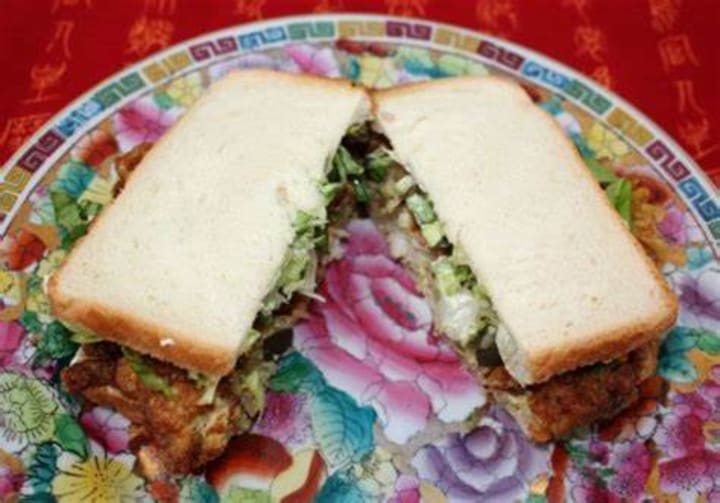The Cuisine of the Midwestern United States
Food known in certain states

Detroit, Michigan specialties include chili dogs called Coney Island hot dogs. Detroit also has its own style of pizza a thick-crusted Sicilian-influenced rectangular type called square pizza.

Other typical foods include zip sauce served on steaks, the triple-decker Dinty Moore sandwich, and a Chinese-American dish called war shu gai or almond boneless chicken. Among large groups of immigrants, there are Arabs, Lebanese, and Greeks. Among the Mediterranean restaurants, typical food such as gyros, hummus, and falafel can be found. Among Polish food, there are foods such as pierogi, borscht, and paczki.

A Detroit-style pizza is a square pizza, with a thick deep-dish crust with toppings placed under the sauce. Some chains are known for their flavored crusts. Sesame, butter, garlic, and onion are among the popular pizza crust flavors.
Indianapolis, Indiana was mostly settled by Americans of British decent, Irish, and German immigrants. Much of its food is considered to be “Classic American Cuisine”. Two of the city’s most distinctive dishes are the pork tenderloin sandwich and strawberry shortcake.

The Pork Tenderloin Sandwich is popular in the Midwest. It was the subject of a 1998 documentary film, “In Search of the Famous Hoosier Breaded Tenderloin”. A Pork Tenderloin sandwich is made exclusively from pork loin and is deep-fried, not pan-fried. It is also served on a bun. It is traditionally prepared from a thinly sliced piece of pork tenderloin and then hammered with a meat mallet. The meat is then dipped in flour, eggs. and breadcrumbs before being deep- fried in oil. It is then served on a hamburger bun. The sandwich can have many condiments such as mustard, lettuce, onions, pickles, and mayonnaise. It is usually served with a side of french fries or sometimes onion rings.

There is a fast-growing population from places such as Mexico and India and they too are beginning to influence local food. The area offers many diverse, locally-owned ethnic restaurants. Indy is also home to many local pubs, including the Slippery Noodle Inn a favorite hangout of the famous bank robber John Dillinger.

In Kansas City, Kansas the most important thing is the barbeque. The Kansas City metropolitan area has more than 100 barbeque restaurants it proclaims itself to be the “world’s barbeque capital.” The Kansas City Barbeque Society spreads its influence across the nation through its barbeque contest standards.

Milwaukee, Wisconsin is known for its strong German influences and serves a lot of bratwurst and beer. Two well-known German restaurants are Mader’s and Karl Ratzsch’s.

Minneapolis and Saint Paul, Minnesota The Twin Cities share the obscure distinction of being associated with the neighborhood Booyah. Booyah or Booya is a food prepared like a stew but on a very large scale. It takes many cooks to prepare the food and is meant to serve hundreds of people. In cooking the booyah one makes a base or broth derived from bones. Beef, chicken, and pork are popular meats and vegetables such as carrots, rutabagas, celery, and potatoes. A wide variety of seasonings are also used. The preparation of the booyah often takes up to two days and is cooked in specially designed booyah kettles that can hold more than 50 gallons of stew. Generally made for charity events, some community groups and churches have their own kettles. Highland Park in St. Paul has a shed with 5 kettles which can yield 350 gallons of booyah.
There is also a strong influx of Asian immigrants and there is a form that combines traditional Midwestern dishes with Asian techniques and spices, such as the Chinese preparations of walleye (a freshwater fish). The Twin Cities-based University of Minnesota has been a center for food research and out of it have come such inventions as the Honeycrisp apple (it is an apple that is ideal for eating raw). Many important agricultural conglomerates make their home in Minneapolis-Saint Paul such as General Mills/Pillsbury, International Multifoods, and Cargill. The Betty Crocker food brand (named after a non-existent housewife) was born there. The Twin Cities claim that the all-American corn dog made its start there, as well as the Pronto Pup (a company now based in Portland, Oregon that manufactures corn dog mix).

A corn dog is a hot dog coated in cornbread batter and deep fried in hot oil, although some are baked. They are served on wooden sticks. The corn dog dates back as early as 1947. Corn dogs are eaten plain or served with ketchup, mustard, relish or mayonnaise. The ingredients of the batter include cornmeal, flour, baking soda, salt, sugar, buttermilk, eggs, and water.

Another dish associated with the Twin Cities is the Juicy Lucy a hamburger with a core of melted cheese. Several national restaurant chains, like Buca di Beppo and Famous Dave’s, got their start in the Twin Cities. Headquartered here are Dairy Queen, T.G.I. Friday’s of Carlson Companies, and Buffalo Wild Wings. There has been immigration from Somalia and Somali community restaurants have opened in the South Minneapolis and West Bank neighborhoods. In St. Paul Southeast Asian restaurants including Vietnamese, Cambodian, and Laotian food can be found along University Avenue. From Norwegian immigrants dishes such as lefse and lutefisk came to Minnesota. Lefse and Lutefisk dinners are held around Christmas and are associated with this holiday.

Lefse is a traditional Norwegian flatbread made out of potato, milk, or cream, and flour and cooked on a griddle.

Lutefisk is made from stockfish (air-dried whitefish) or dried/salted whitefish and soda lye.
Omaha, Nebraska boasts unique steakhouses, several of which are Sicilian in origin or adjacent to the Omaha Stockyards. Central European and Southern influences can be seen in the local popularity of carp. South 24th Street contains a number of Mexican restaurants and North Omaha has its own barbeque style. Omaha is one of the places claiming to have invented the Reuben sandwich. Bronco’s, Godfather Pizza, and the Garden Café are among the chain restaurants that originated here.

The Reuben sandwich is made of corned beef, sauerkraut, Swiss cheese, Russian or sometimes Thousand Island dressing on grilled or toasted rye bread.
There are large numbers of German immigrants in St. Louis, Minnesota who arrived there in the early 19th century. Mayfair salad dressing was invented at a St. Louis hotel of the same name. St. Louis is also known for popularizing the ice cream cone, gooey butter cake, and frozen custard. St. Louis-style barbeque uses pork steaks or pork ribs and a unique type of barbecue sauce. Restaurants of The Hill reflect the influence of the Milanese and Sicilians. Two unique Italian-American style dishes include “roasted” ravioli and St. Louis-style pizza. A St. Paul sandwich is a St. Louis treat available in Chinese-American restaurants.

The Mayfair salad dressing is an egg-based salad dressing that was created at the Mayfair Hotel in St. Louis, Missouri. It is made from corn or canola oil and a whole egg base seasoned with anchovies, garlic, prepared mustard, celery, onion, champagne, and black peppercorns.

Gooey butter cake originated around 1943 and consists of a bottom layer of butter and yellow cake and a top layer made from eggs, cream cheese, and almond extract. Before serving the cake is dusted with confectioner’s sugar.

Toasted ravioli is breaded deep-fried ravioli in restaurant slang known as “T-ravs”. They are an appetizer.

St. Louis-style pizza has a super thin yeast-less crust and uses Provel processed cheese instead of mozzarella. Provel is a trademark for three kinds of cheeses formed into one – Provolone, Swiss, and white Cheddar).

The St. Paul Sandwich consists of an egg foo young patty (made with bean sprouts and minced white onions) served with dill pickle slices, white onion, mayonnaise, lettuce, and tomato between two slices of white bread. It is served in Chinese restaurants.
The Italian Village Chicken Vesuvio Recipe
Ingredients
1 fryer chicken, about 2 to 3 pounds, cut into 8 pieces (2 wings, 2 breasts, 2 legs, 2 thighs)
2 teaspoon salt
1 teaspoon ground black pepper
1/3 cup olive oil
2 cups canola oil, for frying
3 large Idaho or russet potatoes, peeled and cut into thick wedges
2 clove garlic, peeled and mashed
1 tablespoon dried oregano
1/2 cup white wine
2 tablespoons chopped parsley leaves
Directions
Heat oven to 400 degrees F.
Clean chicken, rinse with cold water, and pat dry. Season with salt and pepper. Heat 1/3 cup olive oil in a large heavy skillet over medium-high heat. When the oil is hot, carefully place the chicken in the pan using tongs. Breasts and thighs first, then the rest. Brown well on all sides, and remove the chicken from pan. Pour off all but a few tablespoons of oil. Return chicken to skillet and place uncovered in preheated oven for 25 minutes, turning chicken once or twice.
Heat 2 cups of canola oil to 350 degrees F.
While the chicken is cooking, peel, wedge, rinse, and dry the potatoes. Carefully add wedges into hot oil, about 4 at a time. Avoid crowding. Fry potatoes until golden and remove and let drain on paper towels and reserve for later.
For the last 5 minutes of cooking the chicken, add the cooked potatoes, garlic, oregano, and wine to the skillet and return to the oven.
Remove skillet from oven to stove top after 5 minutes, add parsley, and gently turn with a spoon.
Remove the chicken to a large platter, arrange the potatoes atop the chicken, and pour the pan juices over all.
About the Creator
Rasma Raisters
My passions are writing and creating poetry. I write for several sites online and have four themed blogs on Wordpress. Please follow me on Twitter.






Comments
There are no comments for this story
Be the first to respond and start the conversation.